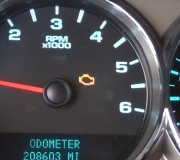I'm getting really confused. When it's idling you want to increase the speed to 4000 rpm. The engine speed pulses at 4000 rpm when the idle speed motor is totally out of the picture but you replaced the idle speed motor. The cruise control works fine going uphill when vacuum is needed to pull on the throttle cable but you're wondering if a vacuum hose is causing a problem.
I'm not sure which direction to go so the best I can do is offer some observations and suggestions. When the car starts going downhill, gravity can let the brake pedal move forward a little. If the brake light switch is out of adjustment, that could cancel the cruise control just as if you tapped the brake pedal. For Chrysler vehicles, their scanner lists the reason for the last cruise control cutout. I'm guessing GM scanners have the same capability. You would have to read that reason during a test drive, otherwise the reason would be "vehicle speed below minimum threshold". If the reason is "brake pedal pressed", you would know to look at the brake light switch.
At 4000 rpm in neutral or park, the Engine Computer may try to limit engine speed because it knows that's not a normal operating condition. Proof would be no pulsing engine speed when driving on the highway. A vacuum leak will cause idle speed to be too high without a corresponding increase in power. The Engine Computer will turn the idle speed motor to close the pintle valve in an attempt to bring the speed down to normal. It will only do that when you are not pressing on the gas pedal. As soon as you move the gas pedal, even a little, the idle speed motor is out of the picture. The only symptom it will cause is an idle speed that is too high or too low and it will be unable to adjust. The air passage it opens could be plugged with carbon in which case it will adjust but the engine speed will stay too low. To test the idle speed motor you need a scanner. I'm more familiar with the Chrysler products but GMs are very similar in this regard. The Engine Computer can set the idle speed motor to any of 256 positions called "steps". As the armature turns to a higher step, it turns a threaded rod that retracts a pintle valve to allow more air to flow around the throttle blade. At the same time the computer commands more fuel from the injectors. With more air and more fuel, idle speed increases.
For a normally running engine, step 32 is about typical for correct idle speed. If idle speed is too high, and the step shown is "0", suspect a vacuum leak. The computer is trying to reduce engine speed without success. If idle speed is too low but the step is around 50 or higher, the air passage is probably plugged with carbon so the extra air can't get through.
Throttle position sensors can cause unusual problems but that isn't real common. They're fed 5.0 volts, then there's mechanical stops that only allow it to send 0.5 to 4.5 volts back to the computer, depending on throttle position. In rare instances it can send the wrong voltage which confuses the computer but as long as it remains within that 0.5 to 4.5 volt range, no fault code will be set.
You have a Check Engine light on and a traction control light which is part of the anti-lock brake system. Those are run by two totally independent computers and have nothing in common except system voltage, meaning the generator. Since the 1987 model year when GM introduced this generator design, they have had a HUGE pile of problems related to it. Due to its design, it produces a lot of big voltage spikes. Those spikes can appear in computer sensor signals and really confuse them. Rough running, stumble or hesitation when trying to accelerate, flickering lights, and various warning lights turning on randomly are the most common symptoms. It is real common to go through four to six replacement generators in the life of the car. To reduce the number of repeat failures, replace the battery at the same time. As they age, they lose their ability to dampen and absorb those voltage spikes even though they will still crank the engine just fine. Unplugging the small connector on the generator turns it off and stops the production of the voltage spikes. If any running problems clear up, replace the generator and battery.
Chrysler is the only manufacturer that has been able to make an engine run right with just a MAP sensor. All other manufacturers use a MAF, (mass air flow) sensor to measure how much air is going into the engine. There can not be any unmetered air sneaking in after the MAF sensor because if the computer doesn't know about it, it won't command enough fuel to go with it. As torque increases, (load on the engine), it can rock a little on the rubber engine mounts and cause the tube between the MAF sensor and throttle body to flex. If there's a leak that opens up and allows extra air in, you could get surging or a hesitation. If you're watching the response of the oxygen sensors with a scanner while that occurs, you would typically see them stay in a lean condition too long rather than switching from rich to lean a couple of times per second. The computer will try to correct that lean condition by commanding extra fuel to go with that air to bring the mixture back to correct. That constant readjusting can lead to surging.
Friday, April 20th, 2012 AT 4:14 AM


